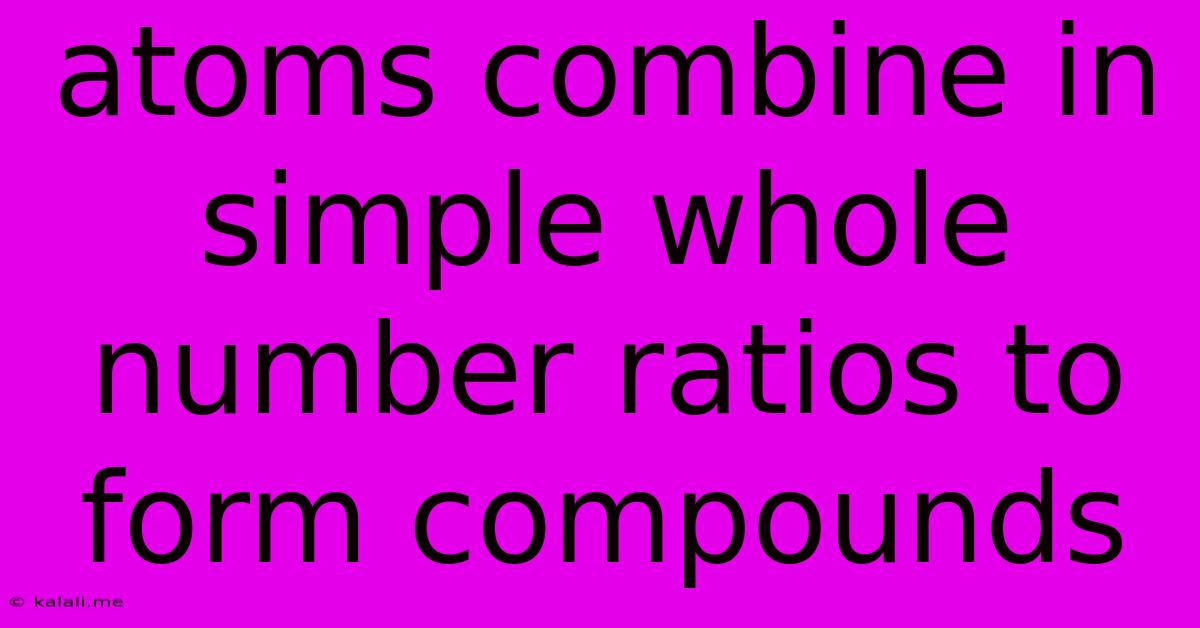Atoms Combine In Simple Whole Number Ratios To Form Compounds
Kalali
Jun 15, 2025 · 3 min read

Table of Contents
Atoms Combine in Simple Whole Number Ratios to Form Compounds: The Law of Definite Proportions Explained
Meta Description: Discover the fundamental principle governing chemical combinations: the Law of Definite Proportions. Learn how atoms combine in simple whole number ratios to form compounds, exploring key concepts and examples.
The world around us is built from matter, and matter is made of atoms. But these tiny building blocks don't exist in isolation; they interact and combine to form the diverse range of substances we encounter daily. A crucial concept governing these interactions is the Law of Definite Proportions, also known as the Law of Constant Composition. This law states that a given chemical compound always contains its constituent elements in a fixed ratio by mass. This means that regardless of the source or method of preparation, the ratio of elements within a specific compound remains constant. This seemingly simple principle is a cornerstone of chemistry, providing a foundation for understanding chemical formulas and reactions.
Understanding the Law: Simple Whole Number Ratios
The Law of Definite Proportions is directly tied to the atomic theory. Atoms are indivisible units, and they combine in simple, whole-number ratios to form compounds. You can't have half an atom of oxygen bonding with one atom of hydrogen; the ratio must be whole. This is because chemical bonds involve the sharing or transfer of electrons, and electrons exist as discrete particles. Fractional numbers of electrons are not possible.
For example, consider water (H₂O). Water always contains two hydrogen atoms for every one oxygen atom. This ratio is consistent whether the water is from a glacier, a tap, or created in a laboratory. The mass ratio of hydrogen to oxygen in water is also always the same, approximately 1:8.
This consistent ratio extends to all compounds. Carbon dioxide (CO₂) always has one carbon atom for every two oxygen atoms. Sodium chloride (NaCl), common table salt, always has one sodium atom for every one chlorine atom. The consistent ratios are not just a coincidence but a direct consequence of the fundamental nature of atoms and their interactions.
Examples Illustrating the Law
Let's look at some specific examples to further clarify the concept:
- Water (H₂O): Regardless of the source – rain, river, or ocean – water always consists of two parts hydrogen and one part oxygen by mass. The exact mass ratio can be calculated using the atomic masses of hydrogen and oxygen.
- Carbon Dioxide (CO₂): Whether produced by respiration, combustion, or volcanic activity, carbon dioxide always maintains a consistent ratio of carbon to oxygen atoms.
- Sodium Chloride (NaCl): Table salt, whether mined or produced synthetically, maintains a 1:1 ratio of sodium to chlorine atoms.
These examples highlight the unchanging nature of the elemental composition within a specific compound, irrespective of its origin or preparation method.
Exceptions and Considerations
While the Law of Definite Proportions is a fundamental principle, there are some exceptions, primarily concerning non-stoichiometric compounds. These are compounds where the ratio of elements deviates slightly from the expected whole-number ratio. This often occurs in solid-state compounds due to defects in the crystal lattice. However, these exceptions are relatively rare and do not invalidate the core principle of the law for the vast majority of chemical compounds.
The Significance of the Law
The Law of Definite Proportions is crucial for several reasons:
- Chemical Formulae: It allows us to write precise chemical formulae representing the composition of compounds.
- Chemical Analysis: It forms the basis for quantitative chemical analysis, allowing us to determine the composition of unknown substances.
- Stoichiometry: It is essential for understanding stoichiometry, the study of quantitative relationships in chemical reactions.
In conclusion, the Law of Definite Proportions is a foundational principle in chemistry, emphasizing the consistent and predictable nature of atomic combinations in forming compounds. Understanding this law is critical for grasping the fundamental principles governing chemical reactions and the composition of matter.
Latest Posts
Latest Posts
-
Max Number Of Tabs In Excel
Jun 16, 2025
-
Difference Between Center Of Gravity And Centroid
Jun 16, 2025
-
Which Figure Has At Least One Line Of Symmetry
Jun 16, 2025
-
Which Heart Chamber Has The Thickest Muscle Wall
Jun 16, 2025
-
What Is The Factors Of 135
Jun 16, 2025
Related Post
Thank you for visiting our website which covers about Atoms Combine In Simple Whole Number Ratios To Form Compounds . We hope the information provided has been useful to you. Feel free to contact us if you have any questions or need further assistance. See you next time and don't miss to bookmark.